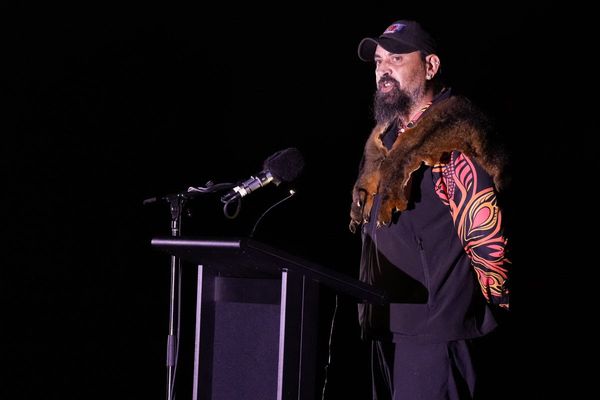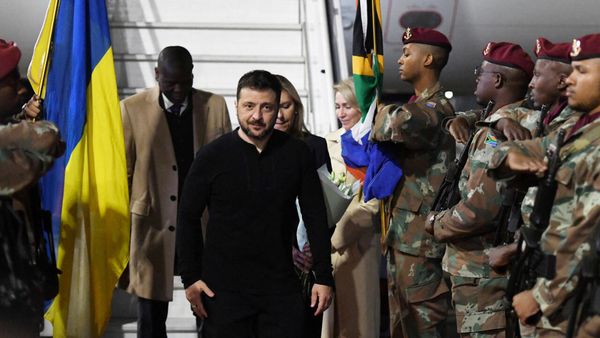
The first events of the Paris Paralympics kicked off early on Thursday, introducing many viewers unfamiliar with parasports to C4-5 track cycling races, SL3 badminton matches and S9 swimming heats. Based on the type and degree of impairment, the Paralympics’ classification system is designed to ensure fair competition between Paralympians. Here’s how it works.
While they share most venues with the Olympic Games, the Paralympics are a separate entity, with their own history, logo, culture and technical language.
In boccia, one of two Paralympic sports that have no Olympic equivalent, players throw or roll leather balls as close as they can to a small ball called a “jack”. In blind football, defenders must signal themselves to the ball carrier by shouting “Voy”, which means “I’m going” in Spanish. Para table tennis allows players to adapt the grip of their racket, using an orthosis (an external device or apparatus) to fix it to their hand if they are unable to hold the handle.
Read moreA guide to the 2024 Paris Paralympics: sports, venues and stars to watch
To ensure fair competition, athletes are grouped by type of impairment – physical, visual or intellectual – and how much of an impact it has on their ability to compete. All Paralympians undergo an assessment by a panel of experts to determine which category they should compete in based on the degree and nature of their disability.
The different categories are defined by a prefix and a number. The SH1 category, for instance, is for rifle shooters with lower limb impairments like amputations or paraplegia who can hold their gun without difficulty and shoot from a standing or sitting position.
FRANCE 24 takes a close look at how the system works in each of the Paralympics’ 22 sports.
-
Blind football
Dominated by defending champions Brazil, blind football involves players who are either blind or visually impaired and a ball containing rattles.
Outfield players must be classified B1 (the B stands for “blind”), meaning they have very low visual acuity and/or no light perception, whereas the goalkeeper can be partially sighted (B2 or B3) or even fully sighted. To ensure fair competition, all outfield players must also wear eye shades.
-
Boccia
Requiring precision and dexterity, boccia is often likened to pétanque or bowls and is unique to the Paralympics.
Players are divided into four categories, labelled BC1 to BC4 (BC stands for “boccia”), depending on their type of disability or impairment. BC2 and BC4 players compete independently, whereas BC1 and BC3 players may have assistance.
-
Goalball
Like boccia, goalball has no equivalent at the Olympics. It is played on an indoor court the size of a volleyball court with goals set up at each end. Teams of visually impaired or blind players take turns rolling a ball containing bells toward the opposing goal while the defending team's players act as goalkeepers. The players must wear an opaque mask as well as an eye patch to ensure fair competition.
To be eligible, athletes must have less than 10 percent visual acuity. As in blind football, they are divided into categories B1 to B3 as follows:
B1: No light perception or inability to recognise a shape.
B2: Visual acuity not exceeding 1/30th after correction or visual field not exceeding 5°.
B3: Visual acuity not exceeding 1/10th after correction or visual field not exceeding 20°.
-
Para archery
Requiring a blend of strength, precision and focus, para archery is open to athletes with physical impairments who are split into the following three categories:
Open class (recurve bows): archers shoot from a standing position at a distance of 70 metres;
Open class (compound bows, for archers with little strength in the arms): archers shoot from a sitting position at a distance of 50 metres;
W1 (compound bows limited in draw weight and without magnifying sights): quadriplegic archers with an impairment in the lower limbs, trunk and one arm shoot from 50 metres.
-
Para athletics
Open to athletes with all types of disability or impairment, whether physical, vision or intellectual, para athletics events are grouped under two letters: “T” for track and jump events, like the marquee 100m sprint race, and “F” for field events, such as shot put and javelin throw.
Numbers are used to classify the type of impairment, with the units digit determining its degree (1 is the highest, 8 is the lowest):
11-13: vision impairment
20: intellectual impairment
31-38: coordination impairments
40-47: short stature, upper limb competing with prosthesis or equivalent, lower limb competing with prosthesis or equivalent
T51-54: wheelchair races
F51-58: seated throws
61-64: lower limb competing with prosthesis
Read moreFrom Gaza to Paris: Paralympian Fadi Deeb vows to show ‘Palestine is not dying’
-
Para badminton
Played in singles or doubles, seated or standing, para badminton events are split into the following categories:
WH1: athletes using a wheelchair with severely impaired leg and trunk function ("WH" stands for “wheelchair”).
WH2: athletes using a wheelchair with minor impairments to leg and trunk function.
SL3: athletes competing standing with a lower limb impairment and balance problems walking or running (SL stands for “Standing/Lower”).
SL4: athletes competing standing with less severe impairment than in SL3.
SU5: athletes with impairment of the upper limbs, including the playing or non-playing hand (SU is for “standing/upper).
SH6: short stature and standing athletes (SH is for “standing/short stature”).
-
Para canoe
Consisting of sprint events only, para canoe includes kayak (KL) and pirogue (VL) races, split into the following three categories:
KL1-VL1: athletes with no or extremely limited trunk function and no function in the legs.
KL2-VL2: athletes with partial leg and trunk function, able to sit up straight in the kayak but may require a high-backed seat.
KL3-VL3: athletes with full function of their trunk and partial function in the legs.
-
Para cycling
Para cycling includes both road and track events, with multiple categories and bikes adapted to athletes’ specific needs.
C1 to C5 (C is for “cycling”): athletes competing with prosthesis or limited movement of upper or lower limbs.
H1 to H5 (H is for “handcycling”): athletes with spinal cord injuries or competing with prosthesis in one or both lower limbs.
T1 and T2 (T is for “tricycle”): athletes with locomotor dysfunction and balance issues (such as hemiplegia).
B (for “blind”): athletes who are blind or vision impaired riding a tandem bike with a sighted partner.
-
Para equestrian
Equestrian returns to the majestic grounds of the Château de Versailles, though only dressage is included in the Paralympics. Athletes compete in five different categories, or “grades”, as follows:
Grade I: severe impairments affecting all limbs and the trunk.
Grade II: either a severe impairment of the trunk and minimal impairment of the arms or moderate impairment of the trunk, arms, and legs.
Grade III: severe impairments in both legs with minimal or no impairment of the trunk or moderate impairment of the arms and legs and trunk.
Grade IV: severe impairment or deficiency of both arms or a moderate impairment of all four limbs or short stature.
Grade V: vision impairment including complete blindness, a mildly impaired range of movement or muscle strength, or a deficiency of one limb or mild deficiency of two limbs.
Read moreParalympics ‘have a special place in our hearts’, Australia’s governor-general tells FRANCE 24
-
Para judo
Para judo is open to athletes with vision impairment alone. Judokas are divided into two groups – blind (B1) and vision impaired (B2 and B3) – and then classed by weight, as in the Olympics.
-
Para powerlifting
Para powerlifting involves athletes with a functional limitation of the lower limbs or hips – such as paraplegia, cerebral palsy or neurological disability – that prevents them from practising standing weightlifting. There are 20 weight categories, ranging from -41kg for women to +107kg for men.
-
Para rowing
Para rowers can have limb deficiency, impaired muscle power or vision impairment, and are divided into three categories (PR stands for “para rowing”):
PR1: single sculls with two oars, reserved for rowers without trunk or leg function.
PR2: mixed double sculls with two oars each, reserved for rowers who can only use their upper body to row.
PR3: coxed four (two women and two men) with one oar each and a coxswain, for athletes using their arms, trunk and legs, and with a maximum of two visually impaired people in the boat.
-
Para swimming
Para swimmers compete in three different styles: S (“swimming”) for crawl, butterfly and backstroke, SB for breaststroke, and SM (“swimming multi”) for medley. Those with physical impairments are then placed in categories numbered 1 to 10 based on the severity of their impairment (1 being the most severe).
Numbers 11 to 14 refer to athletes with vision or intellectual impairments, as follows:
11: extremely low visual acuity and/or no light perception; all swimmers must wear blackened goggles during races to ensure fair competition.
12: higher visual acuity than athletes competing in category 11 and/or a visual field of less than 10 degrees.
13: athletes with the least severe vision impairment eligible for Paralympic sport or a visual field of less than 40 degrees.
14: intellectual impairment resulting in difficulties with pattern recognition, sequencing, and memory, or having a slower reaction time.
-
Para table tennis
Table tennis is split into 11 classes at the Paralympics, five sitting and six standing. Categories TT1 to 5 are for wheelchair athletes (1 being the most severely impaired), whereas TT6 to 10 are for standing athletes. TT11 is for athletes with intellectual impairments.
Players who have difficulty gripping the racket may use an orthosis to attach the racket to the hand or use strapping to maintain their grip of the handle.
-
Para taekwondo
Introduced at the Tokyo Games in 2021, para taekwondo is divided into two categories, under the letter K for “Kyorugi”, the Korean word for sparring. Athletes in both categories are then split into body-weight classes.
K43: athletes with bilateral amputation below the elbow, or equivalent loss of function in both upper limbs.
K44: athletes with unilateral arm amputation (or equivalent loss of function), or loss of toes which impact the ability to lift the heel properly.
-
Para triathlon
The para triathlon events, which include a hotly debated dip in the River Seine, are classified using the letters PT for “para triathlon” combined with the disability category (WC for “wheelchair”, S for “standing” and VI for “vision impairment”).
There are nine classes in total:
PTWC 1-2: athletes with limitations in lower and upper limbs, using a handcycle for the cycling segment and a racing chair for the running segment.
PTS 2-5: athletes with limitations in lower and/or upper limbs who do not require a handcycle for the cycling segment or a racing chair for the running segment. Assistive devices such as prosthetic legs and/or bike modifications are allowed.
PTVI 1-3: athletes with vision impairment, including blind triathletes competing with a guide.
-
Shooting para sport
Shooting events at the Paralympics involve pistols and rifles and sometimes the aid of an assistant to reload guns. Participants are divided into the following two categories:
SH1: athletes able to hold their gun without difficulty and shoot from a standing or sitting position; both pistols and rifles are allowed.
SH2: athletes who are unable to hold their rifle independently and may use a stand, though they aim by themselves and control the rifle when they shoot. Some may have an assistant to reload.
-
Sitting volleyball
Open to players who can move around easily and safely in a seated position, sitting volleyball has two classes: VS1 and VS2 (for athletes with a less severe impairment). Each team can have no more than two VS2 athletes on its roster.
-
Wheelchair basketball
Wheelchair basketball players are classified on a points system, ranging from 1 to 4.5, according to the degree of their impairment. Class 1 athletes are generally unable to rotate their upper bodies, whereas class 4.5 athletes can lean fully forwards, sideways and backwards. To ensure a level playing field, the sum of points for the five players on court for each team must not exceed 14.
-
Wheelchair fencing
Paralympic fencing is open to athletes with physical impairments only, split into two categories:
Category A: disability affecting at least one lower limb.
Category B: disability that prevents voluntary movement of the trunk.
-
Wheelchair rugby
Like its basketball equivalent, wheelchair rugby uses a points system to class players based on their functional abilities, from 0.5 for players with the least physical function to 3.5. Players with the most limited mobility (quadriplegia or equivalent) occupy a primarily defensive position.
The total value for each team of four cannot exceed 8 points.
-
Wheelchair tennis
Played in singles and doubles, wheelchair tennis follows the same rules as non-disabled tennis, with one exception: the ball can bounce twice before being hit back.
Players are divided into two categories: “Open”, for athletes with a lower limb impairment, and “Quad”, for those with both upper and lower limb impairments.
This article was adapted from the original in French.







